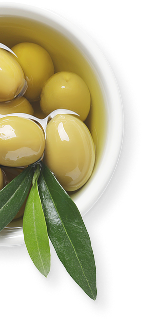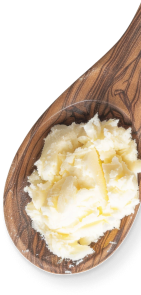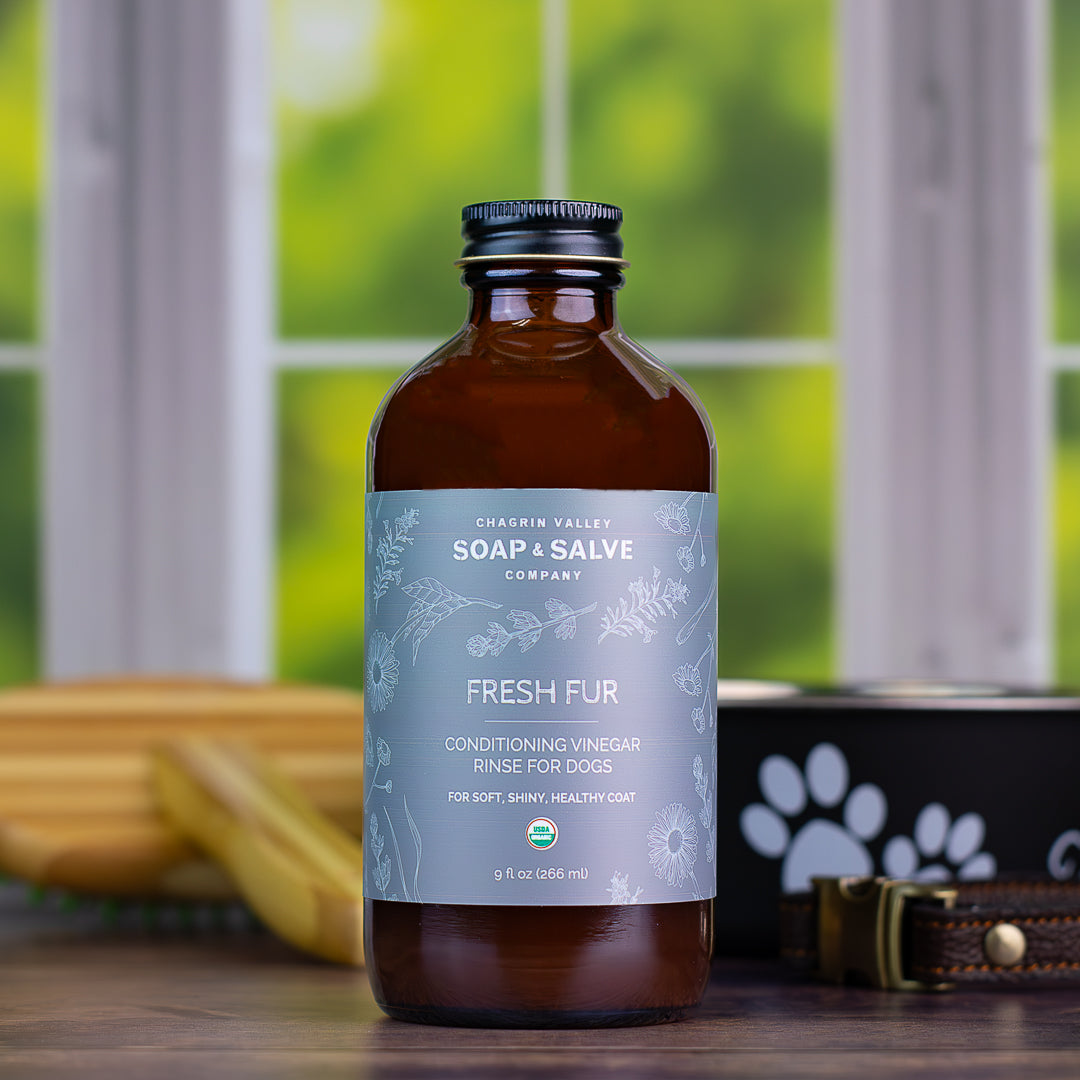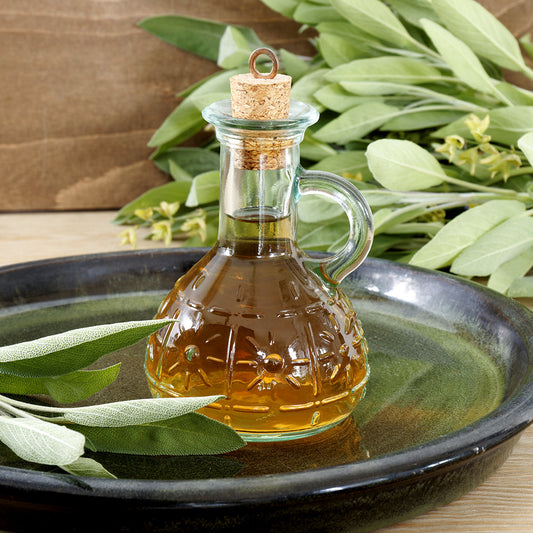Important: When introducing a new product on your dog's skin, do a spot test on a small area of the skin with a tiny amount of the diluted apple cider vinegar. Wait 24 hours and check any irritation or allergic reaction. This ensures your dog's comfort and safety.
Our Herbal Apple Cider Vinegar Fur Rinse is a concentrate, there is no water added. Therefore it must be diluted before using.
A note about dilution: When using Apple Cider Vinegar (ACV) for your dog, proper dilution is crucial. Recommended ratios vary widely. While some suggest a more concentrated ration of 1:1 (example 1 cup ACV to 1 cup water) others suggest a more dilute ratio 1 tablespoon ACV to 16 ounces of water. Since every dog is unique, we provide a suggested dilution range for various applications. Always begin with a mild vinegar solution and gradually increase the ACV concentration if needed.
Since every dog is unique, we provide a suggested dilution range for various applications. Monitor your dog's response and adjust the dilution accordingly.
For a Simple After Bath Rinse
- Place 8 ounces of warm water into a container (measuring cup with a spout, spray bottle, or squirt bottle)
- Add 1/2 - 2 tablespoons of herbal vinegar and mix
- Shampoo and rinse your pup
- Pour, spray or squirt the rinse on the dog's wet coat
- Take care to avoid face and eyes
- Gently massage to distribute vinegar throughout the coat and skin
- You do not need to rinse
- Towel dry
- Vinegar scent will disappear as fur dries
- For large dogs recipe can be doubled
A vinegar rinse can be used after each shampoo and rinse. If you don't like to soap up your dog often, you can use the diluted ACV rinse without shampooing. Simply wet the dog's coat thoroughly and follow the directions above to make the rinse.
Avoid the topical use of ACV if your dog’s skin has open wounds or sores, as it could sting the skin and cause further irritation.
For Very Itchy, Flaky Skin or Dandruff
- Prepare a spray or squirt bottle with 50% apple cider vinegar and 50% water.
- Shampoo and rinse OR just rinse to saturate the coat
- Pour, spray or squirt the rinse of the dog's wet coat
- Take care to avoid face and eyes
- Take extra time to gently massage the herbal vinegar throughout the coat and skin
- You do not need to rinse thoroughly, but you should rinse a bit
- Towel dry
Pet dandruff is easy to detect. It appears as small, white flakes that cling to your dog's fur especially on their back. There are many possible causes of doggie dandruff such as dry skin, food allergies, seasonal allergies, cold weather, stress, and nutritional deficiencies. In many cases, dandruff in dogs will usually subside by itself. However, if the problem is chronic or you have any concerns please check with your vet to determine the best course of treatment.
To Help Repel Fleas
Since fleas and ticks don’t seem to like the smell of the vinegar, an ACV rinse alone can help deter pests. But if your pup is a pest magnet, or you are going hiking or camping a spritz of diluted apple cider vinegar may help prevent flea and tick bites.
- Mix equal parts water and ACV in a spray bottle
- Lightly spray your dog's coat before heading outdoors
- Be sure to avoid the eyes, nose, and mouth
- You can also give their bedding a gentle spritz as well
For Odor Control
Especially in the summer heat, doggie odor can reach its peak. Hot and humid conditions can be the perfect breeding grounds for unwanted bacteria and fungus, which can cause skin and odor problems. An ACV rinse will not simply mask odor like other sprays, it actually helps eliminate the bacteria and fungus that cause the smell.
You can use ACV as an odor eliminator two ways.
- Follow the recipe for the Simple After Bath Rinse shown above, but use a bit higher concentration of vinegar, about 1/2 cup to 1 cup of vinegar to 2 cups of water. OR
- Combine the same ratio in a spray bottle and lightly spray onto dry fur and massage into the skin.
How often to use the spray depends on your pup. You will need to experiment to discover what works best with your dog.
Some people swear by a vinegar rinse bath as a quick and easy way to remove skunk odor. When our pup was sprayed by a skunk it took several days and several washings to remove the odor.
- We applied the vinegar rinse before shampooing and allowed it to dry.
- Then came a shampoo and rinse after which we reapplied the vinegar rinse and allowed her to dry.
Note when making a spray as an insect repellent or for odor control -- make extra. You can safely store your diluted vinegar spray for about month. If you make a very diluted spray you may need to refrigerate.
As a Paw Soak
If your dog has itchy, discolored, or smelly paws, it may be due to seasonal allergies or yeast. Apple Cider Vinegar has antibacterial, antifungal, and antiseptic properties, that can help soothe the irritation on paws from yeast or excessive licking and scratching.
You want a dilution of about 1/2 cup of ACV in 2 cups of water, but the actual numbers will depend on the process that you use. For example if you use a basin, your numbers may be 4 cups ACV to 1 gallon of water.
Now the goal is to soak your pup’s paws in the solution for about three minutes then rinse and pat dry. But, I am a pet parent and my sweet pup will not stand in a puddle for 3 minutes unless I do something to distract her. You can also use a saturated cotton ball or simply spray the rinse on the paws. It may not be as effective as a thorough 3 minutes soaking, but it will help. You can use this dilute treatment daily if needed until symptoms subside.
To Clean Ear Flaps
Dogs with floppy ears are often prone to ear infections because their low-hanging ear flaps trap moisture and create a favorable environment for bacteria and yeast to grow. If you have a floppy-eared friend, apple cider vinegar will make an effective ear flap rinse to use during bath time as well as in between bath days. If you suspect that your dog has an ear infection, please call or visit your veterinarian.
- Mix 2 tablespoons to 1/4 cup vinegar to 1 cup of water.
- Moisten a cotton or gauze pad with the solution and gently wipe away the dirt and debris from the underside of the earflap.
- Never put ACV or insert anything inside the ear canal unless directed by your veterinarian. The ear canals are very delicate and can be easily damaged. Do NOT pour solutions into your dog’s ears and do NOT use cotton swabs like Q-tips. Cleaning the surrounding area will help keep your dog's ears healthy.
For Trouble Spots
Sometimes you canine companion has an itchy spot or two that causes her distress. Apple cider vinegar has a cooling sensation, making it a good choice for small topical problems. A compress or light spritz of diluted herbal ACV applied to the affected area a few times a day can help soothe the irritation.
Again, avoid the topical use of ACV if your dog’s skin has open wounds or sores, as it could sting the skin and cause further irritation.
A word of caution: If your dog has a white or very light coat be sure to check a small area before using the rinse all over. Apple cider vinegar may stain the dog's coat.
Products with essential oils should not be used on cats
*Click here to see our Squeeze Bottle that makes it easy to measure, mix and apply the Vinegar rinse.
This product does not claim to diagnose, treat, cure, or prevent any illness or disease in your pet. If you have any concerns or if your dog has underlying health conditions or sensitivities please consult your veterinarian.

















 Organic Vinagre de sidra de manzana
Organic Vinagre de sidra de manzana
 Organic Raíz de bardana
Organic Raíz de bardana
 Organic Aceite esencial de romero
Organic Aceite esencial de romero

 La albahaca ( Ocimum basilicum) estimula los folículos pilosos, aumenta la circulación del cuero cabelludo y promueve el crecimiento del cabello. Ayuda a proteger el cabello de la rotura, sus propiedades antiinflamatorias ayudan a suavizar las raíces y aporta brillo al cabello opaco.
La albahaca ( Ocimum basilicum) estimula los folículos pilosos, aumenta la circulación del cuero cabelludo y promueve el crecimiento del cabello. Ayuda a proteger el cabello de la rotura, sus propiedades antiinflamatorias ayudan a suavizar las raíces y aporta brillo al cabello opaco.
 El Programa Leaping Bunny fue desarrollado en 1996 por la Coalición para la Información al Consumidor sobre Cosméticos (CCIC) para identificar y apoyar a las empresas que contribuyen a eliminar el uso innecesario y el maltrato de animales en las pruebas de productos e ingredientes cosméticos. La CCIC está compuesta por ocho organizaciones de protección animal, entre ellas la Sociedad Protectora de Animales de Estados Unidos, así como organizaciones de Canadá y Europa.
El Programa Leaping Bunny fue desarrollado en 1996 por la Coalición para la Información al Consumidor sobre Cosméticos (CCIC) para identificar y apoyar a las empresas que contribuyen a eliminar el uso innecesario y el maltrato de animales en las pruebas de productos e ingredientes cosméticos. La CCIC está compuesta por ocho organizaciones de protección animal, entre ellas la Sociedad Protectora de Animales de Estados Unidos, así como organizaciones de Canadá y Europa.
